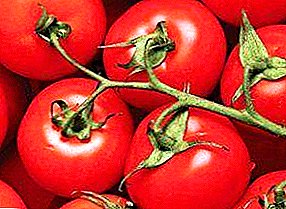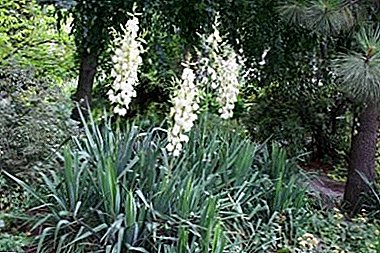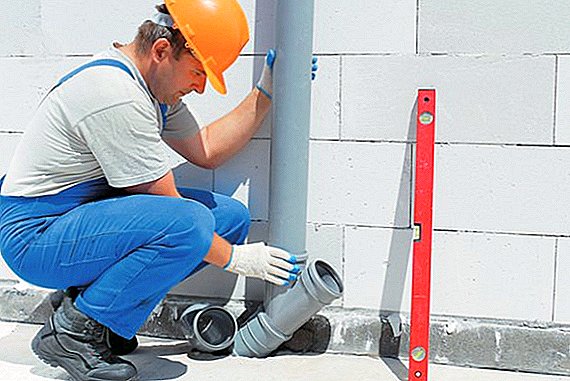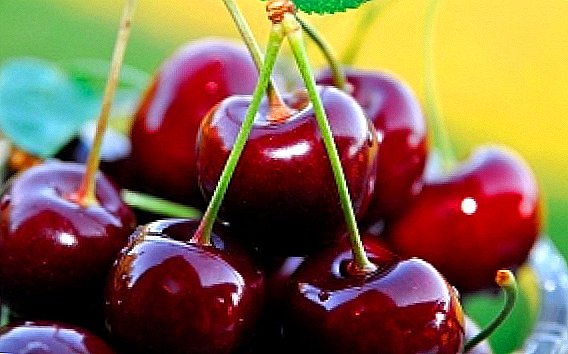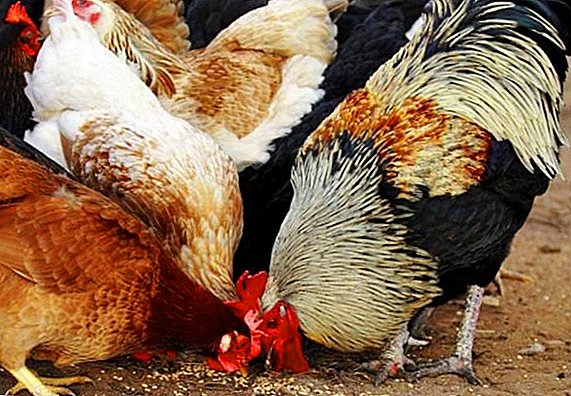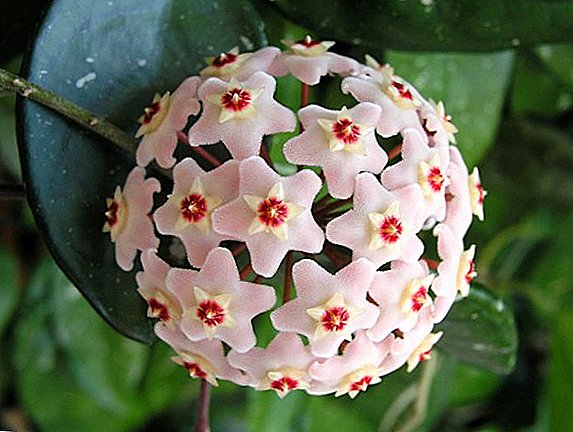 Hoya - ampelnoe plant, belongs to the genus of evergreen shrubs and Lian.
Hoya - ampelnoe plant, belongs to the genus of evergreen shrubs and Lian.
Also called ivy wax.
Hoya grows in South and Southeast Asia, Polynesia and Australia.
Interesting fact! The plant is named Scottish scientist Brown in honor of his friend English gardener Thomas Hoy, who grew plants in the gardens of the Duke of Northumberland.
Optimal hoi growing conditions
Location and lighting
 Hoya prefers good lighting, can easily tolerate direct sunlight. But in the active sun, on the leaves of the vines may form burns.
Hoya prefers good lighting, can easily tolerate direct sunlight. But in the active sun, on the leaves of the vines may form burns.
Hoya is best placed on the western and eastern windows. If the army, all the same, is on the southern window, then in the summer, hoy is better to create a diffused light (throw tulle over the window).
Important! Hoya will not be able to bloom on the north windows.
Temperature mode: summer-winter
In summer, the most optimal temperature for hoyi, which is grown in room conditions, will be 25 degrees Celsius, and in winter - not less than 16 degrees.
If in winter the temperature will exceed 20 degrees Celsius, then the seasonal flowering of hoya will be liquid and insignificant.
It is recommended to conduct frequent airing in the room where hoya grows, but without creating drafts, as the plant may die.
Hoya care tips
Watering: summer-winter
 Hoya - moisture-loving plant. Vine is abundantly watered from March to October, but needs the most active watering during summer periods.
Hoya - moisture-loving plant. Vine is abundantly watered from March to October, but needs the most active watering during summer periods.
As soon as you notice that the ground has dried, you need to water the plant with separated water. Do not forget also to take care of hoey: to clear the stems and the ground under the plant.
Since November, it is recommended to reduce watering hoi. In winter, the plant does not require much moisture, so that it can be watered for 4-5 days after the topsoil has dried. Water temperature for irrigation in winter should be tepid.
Did you know? If hoya is rarely watered, then some roots of the plant die off and the growing season begins.
It is recommended to accelerate the growth of a plant and its flowering; in spring and autumn, immerse it in water at a temperature of 30-40 degrees for half an hour, and the ground with its roots for at least 2 hours.
Air humidity
Hoya is not demanding in matters of moisture. But it will not be superfluous to sprinkle the plant periodically in the spring and summer.
Important! When spraying hoya, moisture should not fall on the flowers.
Top dressing
During the growing season, hoya must be fed every 2-3 weeks. It is recommended to use complex mineral fertilizer for hoya. In winter, the plant does not need feeding.
Need to know! Before you begin to fertilize hoyu, you need to transplant the plant (for young plants, transplantation is needed every year).
Transfer
 It is necessary to replant an adult plant hoi every three years. The plant loves slightly acidic or neutral soil (pH 5.5 to 6). Also, it is recommended to transplant a young plant every year (up to 3 years).
It is necessary to replant an adult plant hoi every three years. The plant loves slightly acidic or neutral soil (pH 5.5 to 6). Also, it is recommended to transplant a young plant every year (up to 3 years).
Hoya unpretentious to the soil. The best substrate for it will be a mixture of clay-sod, greenhouse and leaf earth (2: 1: 1). The second version of the soil: clay-sod, leaf soil, sand and peat (2: 1: 1: 1).
When choosing a soil, you should also consider the type of hoya. For example, Hoya Prekrasnaya loves a mixture of humus, leafy ground, peat, sand and a small portion of charcoal.
Important! Hoey during planting and transplanting need good drainage.
Hoi reproduction at home
 The reproduction of wax ivy at home can be done in three ways: hoya from seeds, grafting and reproduction by layering.
The reproduction of wax ivy at home can be done in three ways: hoya from seeds, grafting and reproduction by layering.
If you become the owner hoi seed, they are planted in the ground, consisting of an earth mixture and peat moss. Plentifully watered and after a week, the seeds begin to germinate. Seedlings of hoi seed should remain moist, but not flooded with water. The seed pot should be kept in a warm and medium-lit place.
To protect young hoi sprouts from fungal diseases, sprinkle them with a solution of copper-containing drugs. After about 3 months, when the shoots release a pair of leaves, transplant them into separate pots.
Interesting fact! Get homemade hoi seeds at home is almost impossible.
 The next breeding method is cutting hoya. It is considered the most reliable and easy way to grow a plant.
The next breeding method is cutting hoya. It is considered the most reliable and easy way to grow a plant.
The cutting you want to plant should be approximately 10 cm. It should have a pair of leaves and nodules. Choi cuttings can be rooted in both water and soil.
When rooting in water, you will need a small foil-wrapped capacity. In the foil, make holes for cuttings. Do not forget to fill the tank with water.
Leave a pair of upper leaves on the cuttings, and treat the lower part with a root growth stimulator. Cut the cuttings through the holes in the foil into the container.
When rooting cuttings, the most optimal temperature is 22 degrees of heat. Do not forget that constant humidity is important for cuttings.
To do this, put a bag on the container with cuttings, leaving an air hole. Thus, the humidity will be constant, but the cuttings will not suffocate.
 Hoya cuttings begin to sprout after 2 weeks. It is necessary to plant the rooted processes in the ground to a permanent place, as the cultivation of the roots weakened the stem, and the cuttings will become even more fragile.
Hoya cuttings begin to sprout after 2 weeks. It is necessary to plant the rooted processes in the ground to a permanent place, as the cultivation of the roots weakened the stem, and the cuttings will become even more fragile.
Also, cuttings can be planted immediately in the substrate. The soil should be light, so that excess water could flow freely.
Before planting, cuttings are necessary process the root. The pot and the substrate must be sterilized, as unformed plants are easily amenable to various diseases and pests.
Cuttings need to be planted to such a depth that the lower bundle is covered with soil. To grow cuttings in this way, constant humidity is also needed.
We perform the same procedure as in the previous method: we put a transparent plastic bag with a hole on the cuttings. After about 3 weeks, signs of plant growth will appear.
 The third way is hoya reproduction by layering. This method makes it possible to get a flowering plant in the year of planting. On the stem of an old plant, make a small incision and cover it with wet moss, covering it with plastic wrap.
The third way is hoya reproduction by layering. This method makes it possible to get a flowering plant in the year of planting. On the stem of an old plant, make a small incision and cover it with wet moss, covering it with plastic wrap.
When the roots appear at the site of the incision, the part with the roots is cut and planted in a permanent pot.
Important! For reproduction by layering, it is recommended to take those stems that have faded.
Hoya is an interesting and beautiful plant. Unpretentious care and reproduction. With proper supervision, you will see its bloom every year.



